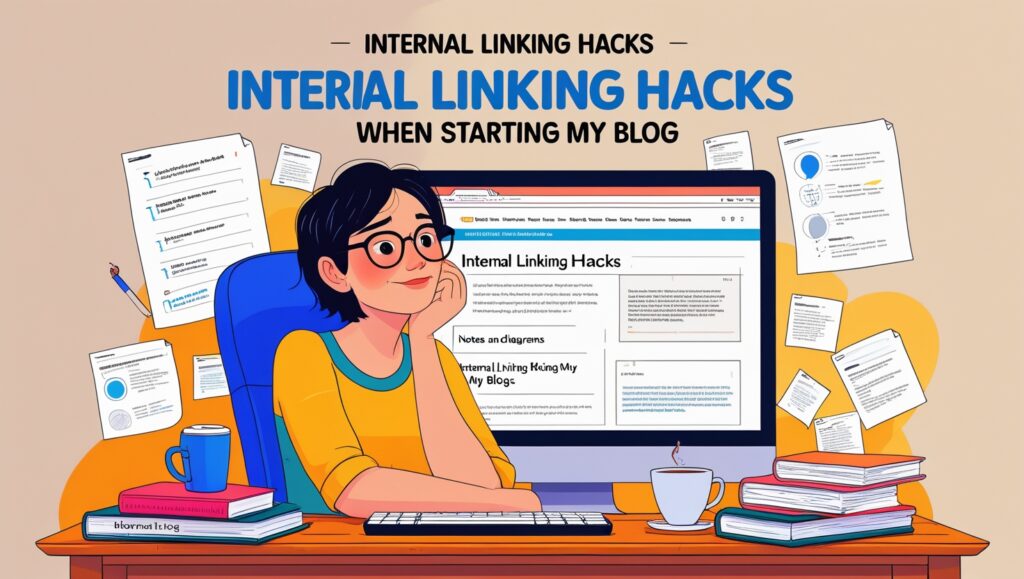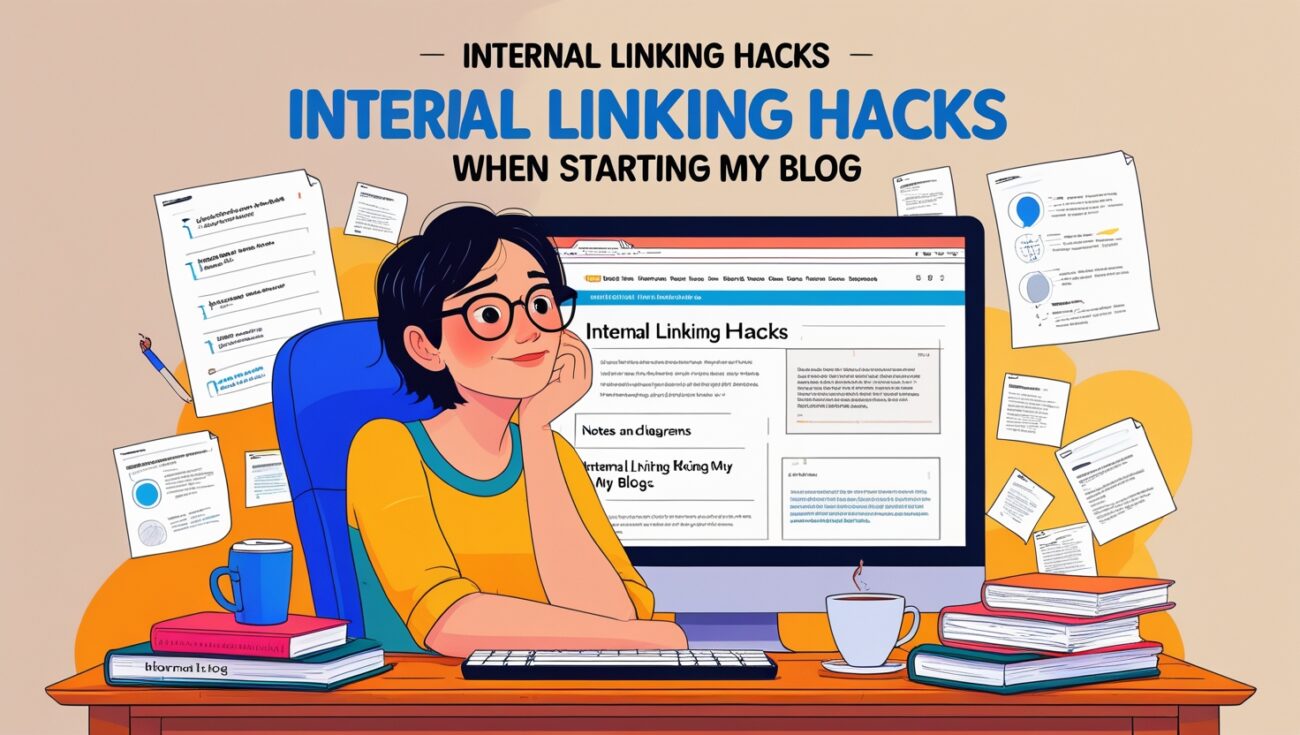Internal Linking Hacks I Wish I Knew When Starting My Blog
When I first started my blog, I was completely focused on creating content and getting people to find it. I spent hours writing, a few more trying to get backlinks, and I completely overlooked one of the most powerful and accessible SEO tools at my disposal: internal links.
I made so many mistakes that cost me valuable time and rankings. But over the years, I’ve learned a few simple “hacks” that have completely transformed my site’s performance.

Table of Contents
If I could go back in time, these are the internal linking secrets I would share with my beginner self. These aren’t complex, technical fixes; they are simple, actionable strategies that deliver huge results and will save you from a lot of SEO headaches down the road.
Hack 1: The “Hub-and-Spoke” Secret
Early on, my blog was just a collection of random articles. I wrote about what I wanted, when I wanted, and there was no real structure. The hack I learned was the Hub-and-Spoke Model. I started creating a central, comprehensive “hub” page for each of my main topics. Then, I wrote more specific “spoke” articles that linked back to the hub. This simple secret created a clear, organized structure that made my site feel more authoritative to both users and Google.
Hack 2: The “Link-as-You-Go” Trick
For my first 50 articles, I never linked to old content. I was so focused on publishing new things that I forgot about all the valuable articles I had already created. The hack is to make internal linking a habit from day one. When you publish a new article, take 5 minutes to go back to 2-3 old, relevant articles and add a link to your new content. This simple trick ensures your new content gets discovered quickly and you build authority from the start.
Hack 3: Rescuing Your Lost “Orphaned” Pages
I was shocked when I ran my first full site audit and discovered dozens of orphaned pages—valuable content with no incoming internal links. These were essentially invisible to search engines and were starved of authority. The hack is to proactively find these hidden gems and connect them to your main site. It’s a huge, easy win. I use a tool like Linkbot to easily find all of my orphaned pages, and it’s one of the most valuable hacks I’ve ever learned.
Hack 4: The “Anchor Text” Superpower
I used to use generic anchor text like “read more” or “check this out.” The hack I learned is that anchor text is a powerful signal. By using descriptive and keyword-rich phrases, you’re not only giving your users a better idea of what’s on the other side of the link, but you’re also telling Google exactly what the destination page is about. This small change provides a huge SEO boost.
Hack 5: The “Topical Cluster” Shortcut
I used to think that the more content I had, the better. But I now know that it’s about connecting that content. The hack is to think in “topical clusters.” When you’re writing a new article, find 3-5 existing, highly relevant articles on your site and link them all to the new one. This creates a powerful network that signals your expertise and helps your entire cluster of articles rank better.
The Automation Hack I Can’t Live Without
These hacks are powerful, but they are also a lot of work to manage manually. As my site grew, I couldn’t keep track of everything. The ultimate hack for me was to stop doing it all myself and to start using automation. Automated internal linking software can analyze your website and provide you with a prioritized, actionable list of linking opportunities. It’s the ultimate productivity hack that ensures you never miss a chance to build a stronger website. With Linkbot, you can automate this crucial part of your SEO.
Conclusion: Stop Guessing and Start Hacking Your SEO
You don’t need to spend thousands of dollars or wait years to see results. By implementing these simple internal linking hacks, you can build a powerful, authoritative website from the ground up and get your content to rank faster. These aren’t just shortcuts; they are foundational SEO practices that will save you time and deliver real, tangible results.
Don’t make the same mistakes I did. Start using these internal linking hacks today and watch your blog’s performance soar. Ready to take control of your SEO? Explore how Linkbot can simplify your internal linking today.
My journey taught me that a major mistake is thinking that SEO is just about creating new content. I moved my focus from creating new things to optimizing the existing things on my site, and that’s when I saw the real change. These internal linking hacks taught me to stop just creating and to start strategically connecting. The content I had already written was the foundation for my future success.
I also noticed a significant improvement in my website’s crawl budget. Before I focused on these hacks, Google’s bots were navigating a scattered collection of pages, often hitting dead ends or loops. By creating a clear, logical site architecture with smarter internal links, I made it incredibly efficient for the bots to crawl and index every single page, ensuring none of my valuable content went undiscovered.
The power of these internal linking hacks is their compounding effect. Each time you add a thoughtful, relevant link, you are making your entire website more authoritative and resilient. These small, consistent improvements add up to a significant competitive advantage over the long term, making your website an increasingly powerful asset. It’s a foundational, evergreen tactic that continues to build momentum over time.
One of the most powerful hacks I learned was the “deep link” trick. Instead of just linking to my homepage or a broad category, I started linking directly to specific product pages, services, or case studies. This simple act provided a much clearer next step for my user and a stronger signal to Google, which helped those pages rank faster and even contributed to more conversions.
One of the greatest benefits I got from using an automated tool to manage my internal links was the “to-do” list it provided. Instead of being overwhelmed by the sheer size of my website, the tool gave me a prioritized, actionable list of connections to make. It transformed a monumental, frustrating task into a series of manageable steps that I could tackle in just minutes.
The return on investment for this specific SEO strategy was unlike any other tactic I had tried. Unlike expensive ad campaigns or time-consuming guest-posting efforts, my internal linking overhaul was a completely free way to get more traffic. The cost was minimal, and the results were permanent, a significant advantage for any blogger with a limited budget.
I’ve learned that the simplicity of a clean URL structure works in perfect harmony with these internal linking hacks. A clear hierarchy like yourwebsite.com/category/article-title makes it easy for both users and search engines to understand where they are on your site and what the content is about. This clarity works with your links to signal expertise and build a trustworthy site.
I felt like I was finally in the driver’s seat of my SEO. For years, I had relied on external factors, which felt like I was giving up control of my SEO destiny. But by mastering my internal links, I was proactively building my site’s authority from the inside out, on my own terms, which was an empowering and exciting feeling.
When a user or a search engine bot lands on your page and sees a clear network of interconnected, relevant articles, it signals that you are a serious, comprehensive resource. A site filled with well-placed internal links feels more professional and trustworthy. It helps with a site’s overall perceived authority and builds a strong foundation for future growth.
I’ll never forget the first time I fixed a few internal links on a page that was struggling to rank, and it shot up in the search results almost overnight. It was a piece of content I had worked hard on and then forgotten about. This personal experience proved to me that the work I had already done held incredible, untapped value, just waiting to be unlocked.
These hacks are not just about ranking; they are also about building a better, more user-friendly website. A site that is easy to navigate, with a clear flow of information, is a site that users will love and a site that Google will reward. It’s a win-win for everyone involved, and it’s what ultimately helped me succeed.
By implementing these internal linking hacks, you are also directly addressing Google’s E-E-A-T framework. You are demonstrating expertise by creating topical clusters, you are showing authority by linking from strong pages, and you are providing a better user experience, which is a key part of what Google looks for.

